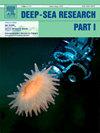Vertical zonation and environmental drivers of North-West Pacific abyssal and hadal mobile faunal communities
IF 2.1
3区 地球科学
Q2 OCEANOGRAPHY
Deep-Sea Research Part I-Oceanographic Research Papers
Pub Date : 2024-11-16
DOI:10.1016/j.dsr.2024.104418
引用次数: 0
Abstract
This study examines the composition, vertical zonation and drivers of mobile abyssal and hadal faunal assemblages to understand the environmental patterns underlying biological organisation at lower abyssal and hadal depths. Biological data were analysed from 96 baited lander deployments across five North-West Pacific subduction trenches and one triple trench junction (the Mariana Trench, Philippine Trench, Ryukyu Trench, Japan Trench, Izu-Ogasawara Trench and Boso Triple Junction) and combined with environmental metrics of terrain geomorphology and oceanography at deployment locations. Hierarchical clustering revealed three depth-driven faunal zones, representing an abyssal-hadal transition community (∼5500–6500 m), an upper hadal community (∼7000–7500 m) and a lower hadal community (>8500 m). Clustering results support an abyssal-hadal ecotone >6500 m depth and a further hadal transition ∼8000 m. Environmental factors explained 40.4% of community structure, with depth and location as main contributors to the final model. These factors, through the latter's relationships with surface oceanography and productivity, were also key determinants of relative abundance, diversity, richness and the total relative abundance of dominant faunal groups and families among deployments. Results suggest limited ecological effects of intra-trench environmental variability, and highlight a need for further high-resolution studies sampling a range of environmental conditions and their associated biodiversity within individual hadal features.
西北太平洋深海和浅海移动动物群落的垂直分带和环境驱动因素
本研究考察了移动深海和海槽动物群落的组成、垂直分带和驱动因素,以了解下深海和海槽生物组织的基本环境模式。对在西北太平洋五个俯冲海沟和一个三海沟交界处(马里亚纳海沟、菲律宾海沟、琉球海沟、日本海沟、伊豆-小笠原海沟和房总三海沟交界处)部署的 96 个带饵着陆器的生物数据进行了分析,并与部署地点的地形地貌和海洋学环境指标相结合。分层聚类发现了三个深度驱动的动物群落区,分别代表深海-咸海过渡群落(5500-6500 米)、上咸海群落(7000-7500 米)和下咸海群落(8500 米)。环境因素对群落结构的解释率为 40.4%,深度和位置是最终模型的主要贡献因素。这些因素,通过后者与表层海洋学和生产力的关系,也是决定各布放点相对丰度、多样性、丰富度以及主要动物群和科的总相对丰度的关键因素。研究结果表明,海沟内环境变化对生态的影响有限,并强调有必要进一步开展高分辨率研究,对各个海沟地貌内的一系列环境条件及其相关生物多样性进行取样。
本文章由计算机程序翻译,如有差异,请以英文原文为准。
求助全文
约1分钟内获得全文
求助全文
来源期刊
CiteScore
4.60
自引率
4.20%
发文量
144
审稿时长
18.3 weeks
期刊介绍:
Deep-Sea Research Part I: Oceanographic Research Papers is devoted to the publication of the results of original scientific research, including theoretical work of evident oceanographic applicability; and the solution of instrumental or methodological problems with evidence of successful use. The journal is distinguished by its interdisciplinary nature and its breadth, covering the geological, physical, chemical and biological aspects of the ocean and its boundaries with the sea floor and the atmosphere. In addition to regular "Research Papers" and "Instruments and Methods" papers, briefer communications may be published as "Notes". Supplemental matter, such as extensive data tables or graphs and multimedia content, may be published as electronic appendices.

 求助内容:
求助内容: 应助结果提醒方式:
应助结果提醒方式:


